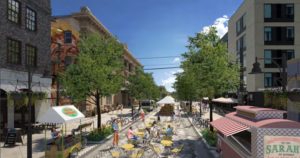In Missoula, we love a Master Plan – here’s our take on what’s in store for Downtown
In late 2019, a Master Plan for Missoula Downtown wrapped up. It was the culmination of a tremendous effort. Lots of voices, data, and insights weighed into the final (211-page) product.
The outcomes were pretty clear and resonated with much of Missoula. The Master Plan made recommendations for improved health and safety. There was a nod for better transportation planning, and a continued emphasis on nurturing parks, trails, and the river. Finally, it included a reminder to stay true to our arty roots (keep Missoula weird, if you will). There was also a note about fostering an inclusive downtown community.
Development Potential
Development potential is positive in the downtown area. Retail, hospitality, office, and housing all projected to grow in the coming years. While this plan was finalized just before COVID-19 hit in spring 2020, Missoula’s economy was largely stable throughout the pandemic and these numbers are still in a reasonable range.

Private developers feature prominently in the Downtown Master Plan. One key area for developers: parking. It’s expensive and cumbersome, and the plan designers suggest developers could pay parking-in-lieu fees. Then, fees are funneled to construct parking garages instead of on-site parking.
The plan also suggests modernizing the parking codes and policies. That’s so large-scale projects with onerous parking requirements might find a better solution that allows the development to pencil out. Developers may also be able to provide subsidized transportation options as a means of parking mitigation.
Per the plan, developers should work carefully in tandem with the City when it comes to water flow and fire suppression systems. That’s largely because these systems may need upgrades and/or extensions as new development takes place in the downtown area.
It’s also clear that Missoulians indicated a strong preference for development that restores or reuses historical structures. But, those projects can come with significant price tags. The plan suggests Adaptive Reuse Ordinances to provide incentives “such as tax credits, expedited approvals, density bonuses, and parking reductions.”
Finally, smaller units help keep costs in check while serving the rising need for housing in Missoula. The need is definitely clear. With less than 1% multifamily vacancy – and a growing student and retiree population – higher density could serve the community as it grows.
Takeaway
The Downtown Master Plan makes for spaces that are cohesive, inclusive, and reflect Missoula’s spirit. The downside is, these spaces are usually more expensive.
For more info on development in Missoula, contact Matt Mellott.



